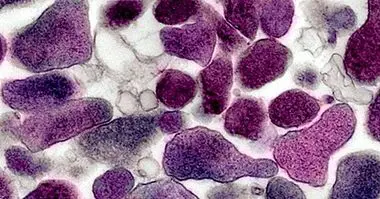The 8 most effective flu medications
The flu is a problem that most people face or have faced one or more times throughout our lives . It is a disease that has the potential to be deadly (in fact throughout history it has been numerous times) but nowadays in societies like ours, it tends not to be more than a nuisance in the majority of cases.
However, treating a flu is more complicated than it seems. In fact, there are no drugs that "cure" the flu, being the medical treatment mainly dedicated to reducing the affectation and the symptoms caused by the fact of suffering it. What medicines for the flu exist and what are they for? In this article, we will briefly explore this question.
Defining the flu
Before going into what medicines are used to alleviate their symptoms, it might be useful to go on to define what is the flu, which at the popular level is often confused with the common cold.
Influenza is understood as a viral infection of the respiratory tract, usually caused by the influenza virus. Although we generally talk about flu as something general, the fact is that the influenza virus mutates easily and different strains and subtypes that generate different types of flu can be found. Specifically, there are three main types: A, B (these two are the most frequent and so-called seasonal flu) and C, although new strains may appear from time to time, as happened with swine flu or bird flu.
The main symptoms of most flu usually include fever, headache, sore throat, runny nose, muscle pain, altered thermal perception and chills. It is frequent that it generates respiratory alterations, like difficulty when inhaling and coughs. In fact, its most important and dangerous complication is pneumonia.
The contagion of this disease can occur in different ways, which usually include contact with fluids of a sick person through nasal, buccal or conjunctival routes. For example, it can be transmitted through saliva or even through the air, such as after a sneeze or a kiss.
Main medications used in people with influenza
As we have indicated previously, the flu does not yet have a curative treatment, and the organism must overcome it on its own. Medical intervention will be based on the fight against symptoms and discomfort generated by this . In this sense, in most cases you can prescribe a series of medicines for influenza that we will mention below.
1. Antivirals
Zanamivir and oseltamivir (better known as tamiflu) have been considered drugs with some effectiveness in preventing the virus from reproducing within the body , being inhibitors of the neuroaminidase enzyme (which allows the release of the virus from the infected cells towards the others). The first one is used inhaled, while the second is given orally.
Although it does not eliminate the infection, in principle it allows controlling its expansion and can also serve as prophylaxis. They produce some improvement and can shorten the time when the virus is in our body, but they are not able to cure the condition. Neither have they shown a real effect in the prevention of respiratory complications.
Because the improvement they imply is limited and in some cases can cause problems and side effects, they are not usually recommended or prescribed. In fact, its effectiveness is considered low and many people consider it a fraud.
2. Analgesics
Since the pain generated by the infection in the throat, head and joints is usually one of the most annoying symptoms, One of the main medications that are prescribed in case of flu are analgesics . Paracetamol stands out as one of the most popular.
3. Antipyretics
Controlling body temperature and fever is also necessary when we are suffering from the flu , so that the group of medicines known as antipyretics have also been used to reduce it.
4. Antihistamines
The improvement of nasal symptoms such as runny nose, although it usually occurs by itself in a few days , can be induced from the application of antihistamines.
5. Analgesic-non-steroidal anti-inflammatories
If we hear this name, it may seem strange to us, but the truth is that it is the group of medicines of which ibuprofen is a part . They serve both as an analgesic and antipyretic, reducing fever and pain. It also has some anti-inflammatory effect.
6. Antitussives
Respiratory conditions are very frequent during the flu, with cough being one of the most common symptoms.That is why sometimes it can be prescribed some antitussive that reduces this symptom, although it is common that they have little effect.
Usually syrups or creams are applied to the skin to release vapors that are going to be inhaled over time. There are other products for this, being one of the most powerful (and reserved for cases where cough is very annoying and generates pain) codeine. On a more natural level you can turn to foods such as honey .
7. Influenza
Despite its name, the flu does not really fight against the viral infection of the flu but focuses on alleviating their symptoms . As a general rule it is the combination of an analgesic, antihistamine and antitussive. They are not usually prescribed at a clinical level, but they are still very popular and reduce a large number of symptoms or the discomfort they generate. They are usually the type of product that we see advertised on television (specifying that they are dedicated to combating the symptoms), existing widely known and used brands.
8. Antibiotics
Although it is not usual, In some cases, the flu can be complicated if, in addition to the virus itself, a bacterial infection is suffered. . In these cases it may be necessary to use antibiotics such as amoxicillin. However, the effect is only in the bacterial infection, not on the flu itself (which is a viral infection on which antibiotics have no effect).
The vaccine as real prevention
Although the treatments that are applied for the flu are not curative but merely palliative, the truth is that we have ways to prevent their contagion. Specifically we are talking about the flu vaccine, which should be applied annually. An inactivated sample of the virus is injected into the body so that the subject's organism generates antibodies that prevent future infections. But nevertheless it must be taken into account that there are multiple viruses that the flu virus is very mutable, resulting in the easy appearance of new strains .
Although a large part of the population does not wear it, it is essential for that population for whom contracting the flu can be a danger. This is the case of the population that has reduced defenses, as occurs with the elderly, children and the chronically ill and / or immunosuppressed (for example, people suffering from HIV infection or diabetes).



















